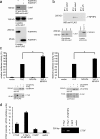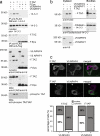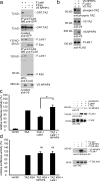NPHP4, a cilia-associated protein, negatively regulates the Hippo pathway
- PMID: 21555462
- PMCID: PMC3166863
- DOI: 10.1083/jcb.201009069
NPHP4, a cilia-associated protein, negatively regulates the Hippo pathway
Abstract
The conserved Hippo signaling pathway regulates organ size in Drosophila melanogaster and mammals and has an essential role in tumor suppression and the control of cell proliferation. Recent studies identified activators of Hippo signaling, but antagonists of the pathway have remained largely elusive. In this paper, we show that NPHP4, a known cilia-associated protein that is mutated in the severe degenerative renal disease nephronophthisis, acts as a potent negative regulator of mammalian Hippo signaling. NPHP4 directly interacted with the kinase Lats1 and inhibited Lats1-mediated phosphorylation of the Yes-associated protein (YAP) and TAZ (transcriptional coactivator with PDZ-binding domain), leading to derepression of these protooncogenic transcriptional regulators. Moreover, NPHP4 induced release from 14-3-3 binding and nuclear translocation of YAP and TAZ, promoting TEA domain (TEAD)/TAZ/YAP-dependent transcriptional activity. Consistent with these data, knockdown of NPHP4 negatively affected cellular proliferation and TEAD/TAZ activity, essentially phenocopying loss of TAZ function. These data identify NPHP4 as a negative regulator of the Hippo pathway and suggest that NPHP4 regulates cell proliferation through its effects on Hippo signaling.
Figures





Similar articles
-
Regulation of Hippo pathway transcription factor TEAD by p38 MAPK-induced cytoplasmic translocation.Nat Cell Biol. 2017 Jul 28;19(8):996-1002. doi: 10.1038/ncb3581. Nat Cell Biol. 2017. PMID: 28752853 Free PMC article.
-
Vestigial-like family member 3 (VGLL3), a cofactor for TEAD transcription factors, promotes cancer cell proliferation by activating the Hippo pathway.J Biol Chem. 2020 Jun 26;295(26):8798-8807. doi: 10.1074/jbc.RA120.012781. Epub 2020 May 8. J Biol Chem. 2020. PMID: 32385107 Free PMC article.
-
The ciliopathy disease protein NPHP9 promotes nuclear delivery and activation of the oncogenic transcriptional regulator TAZ.Hum Mol Genet. 2012 Dec 15;21(26):5528-38. doi: 10.1093/hmg/dds408. Epub 2012 Oct 1. Hum Mol Genet. 2012. PMID: 23026745
-
Reciprocal regulation of YAP/TAZ by the Hippo pathway and the Small GTPase pathway.Small GTPases. 2020 Jul;11(4):280-288. doi: 10.1080/21541248.2018.1435986. Epub 2018 Apr 20. Small GTPases. 2020. PMID: 29457552 Free PMC article. Review.
-
Hippo pathway inhibition by blocking the YAP/TAZ-TEAD interface: a patent review.Expert Opin Ther Pat. 2018 Dec;28(12):867-873. doi: 10.1080/13543776.2018.1549226. Epub 2018 Dec 2. Expert Opin Ther Pat. 2018. PMID: 30482112 Review.
Cited by
-
Notch activity modulates the responsiveness of neural progenitors to sonic hedgehog signaling.Dev Cell. 2015 May 26;33(4):373-87. doi: 10.1016/j.devcel.2015.03.005. Epub 2015 Apr 30. Dev Cell. 2015. PMID: 25936505 Free PMC article.
-
Nuclear p120 catenin unlocks mitotic block of contact-inhibited human corneal endothelial monolayers without disrupting adherent junctions.J Cell Sci. 2012 Aug 1;125(Pt 15):3636-48. doi: 10.1242/jcs.103267. Epub 2012 Apr 14. J Cell Sci. 2012. PMID: 22505615 Free PMC article.
-
Expanding the Spectrum of FAT1 Nephropathies by Novel Mutations That Affect Hippo Signaling.Kidney Int Rep. 2021 Jan 29;6(5):1368-1378. doi: 10.1016/j.ekir.2021.01.023. eCollection 2021 May. Kidney Int Rep. 2021. PMID: 34013115 Free PMC article.
-
Functional aspects of primary cilium in signaling, assembly and microenvironment in cancer.J Cell Physiol. 2021 May;236(5):3207-3219. doi: 10.1002/jcp.30117. Epub 2020 Oct 26. J Cell Physiol. 2021. PMID: 33107052 Free PMC article. Review.
-
Insights into the Regulation of Ciliary Disassembly.Cells. 2021 Nov 1;10(11):2977. doi: 10.3390/cells10112977. Cells. 2021. PMID: 34831200 Free PMC article. Review.
References
Publication types
MeSH terms
Substances
LinkOut - more resources
Full Text Sources
Other Literature Sources
Medical
Molecular Biology Databases

